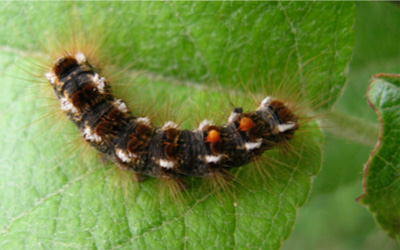Browntail Moth


Varicella (Chickenpox) is a highly contagious disease caused by the varicella-zoster virus. It mainely spreads from unvaccinated people with chickenpox to other people who have never had the virus before. It causes an itchy, blister-like rash in most people.
Varicella-zoster virus also causes shingles. After people recover from chickenpox, the virus stays dormant in the body. This virus can reactivate later in life and cause shingles.
The best way to prevent chickenpox is to get the chickenpox vaccine.
Smallpox is an acute, contagious, and sometimes fatal disease caused by the variola virus, and marked by fever and a distinctive progressive skin rash. Prolonged face-to-face contact is required to spread smallpox from one person to another. Smallpox also can be spread through direct contact with infected bodily fluids or contaminated objects such as bedding or clothing.
Rubella (German Measles) is an infection caused by the rubella virus. It is spread by mucus or droplets from the nose or throat of an infected person, usually when a person coughs or sneezes. Children with rubella usually break out in a rash, which starts on the face and moves down the body. Older children and adults usually suffer first from a fever, swollen glands, and upper respiratory infection before they develop a rash. Rubella infection in the first trimester of pregnancy can lead to fetal death, premature delivery and serious birth defects.
Hand, foot, and mouth disease (HFMD) is caused by a group of viruses, called enteroviruses. HFMD occurs mainly in infants and children under 5 years old, but it can also occur in adults
Maine CDC works to monitor and prevent infectious diseases in Maine. These diseases are caused by certain viruses, bacteria, fungi, or parasites. Viral infections that can cause rashes include chickenpox, shingles, rubella, and more.
RSV is a respiratory virus that usually causes mild, cold-like symptoms. Healthy people typically recover in a week or two, but RSV can be serious for infants or older adults. RSV is most common in the fall and winter months.
People with RSV usually show symptoms 4 to 6 days after getting infected. Common RSV symptoms include:
Legionella bacteria are common in the natural environment. There are over 60 different species of Legionella, but the species Legionella pneumophila is the one overwhelmingly found in association with disease cases and outbreaks.
Hepatitis means inflammation of the liver. Toxins, certain drugs, some diseases, heavy alcohol use, and bacterial and viral infections can all cause hepatitis. Hepatitis is also the name of a family of viral infections that affect the liver; the most common types in the United States are hepatitis A, hepatitis B, and hepatitis C.